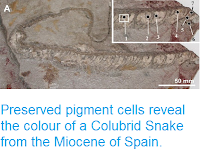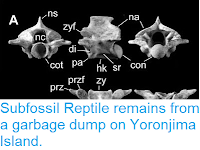Snakes are one of the
most successful groups of living vertebrates, with over 3000 living
species found in all but the very coldest environments on Earth. However their maximum diversity is thought to have occurred between the Late Cretaceous and end of the Eocene, when many Snake groups, some still living, but many extinct, spread around the margins of the tropical Tethys Ocean. Among these Snakes were two groups of large aquatic Snakes, the Palaeophiidae, a group thought to have produced the largest Snakes ever to have lived, and the slightly smaller Nigerophiidae.
In a paper published in the journal Acta Palaeontologica Polonica on 7 May 2018, Jacob McCartney of the Department of Biology at the State University of New York College at Geneseo, Eric Roberts of the Department of Earth and Oceans at James Cook University, Leif Tapanila of the Department of Geosciences and Idaho Museum of Natural History at Idaho State University, and Maureen O’Leary of the Department of Anatomical Sciences at Stony Brook University, describe a series of new Palaeophiid and Nigerophiid Snake remains from deposits in Mali associated with the Trans-Saharan Seaway, a subtropical epeiric sea that episodically connected the Tehtys Ocean (to the north) to the Gulf of Guinea (to the south), which were excavated during two expeditions conducted jointly by Stony Brook University and the Centre National de Recherche Scientifique et Technologique of Mali in 1999 and 2003.
Firstly McCartney et al. describe new material which they attribute to the Early Eocene species Palaeophis colossaeus, which has been previously described from phosphate deposits of the Tamaguilelt Formation. The species is known only from isolated vertebrae, even with the new material involved, though McCartney et al. are able to use the new material to revise size estimates of this species, though they do this with some caution as it is difficult to estimate the size of an animal when no even partially articulated specimen is known of it or any close relative, estimating that, the species reached somewhere between 8.1 and 12.3 m in length. Even the lower estimate for the length of Palaeophis colossaeus is considerably larger than any living Snake species, and matched only by the extinct Gigantophis garstini from the upper Eocene of Egypt, estimated to have reached 9.3 to 10.7 m, and Titanoboa cerrejonensis from the Paleocene of Colombia, which is estimated to have reached a maximum length of 12.8 m.
Secondly McCartney et al. describe a new species of Nigerophiid Snake from the Palaeocene Teberemt Formation of northeastern Mali. This is named Amananulam sanogoi, where 'Amananulam' means 'Water Snake' in the Tuareg language Tamasheq, and 'sanogoi' honours Mamadou Sanogo, for his contributions to the Stony Brook University/Centre National de Recherche Scientifique et Technologique expditions. The species is described from a single, damaged mid-trunk vertebra, 10 mm in length (though this is slightly less than it would have been in life, due to the damage to the specimen). This is estimated to have come from a Snake about 2.1 m in length, comparable to the largest living Sea Snakes.
Finally McCartney et al. describe a possible anterior trunk vertebra from an unknown Snake from the Early Eocene Tamaguilelt Formation. This is not well enough preserved to assign to a species or even family, but is notably due to its size, with a width of 13.7 mm, and it is estimated to have come from a Snake around 5.4 m in length, comparable to the largest Boas and Pythons today.
See also...
In a paper published in the journal Acta Palaeontologica Polonica on 7 May 2018, Jacob McCartney of the Department of Biology at the State University of New York College at Geneseo, Eric Roberts of the Department of Earth and Oceans at James Cook University, Leif Tapanila of the Department of Geosciences and Idaho Museum of Natural History at Idaho State University, and Maureen O’Leary of the Department of Anatomical Sciences at Stony Brook University, describe a series of new Palaeophiid and Nigerophiid Snake remains from deposits in Mali associated with the Trans-Saharan Seaway, a subtropical epeiric sea that episodically connected the Tehtys Ocean (to the north) to the Gulf of Guinea (to the south), which were excavated during two expeditions conducted jointly by Stony Brook University and the Centre National de Recherche Scientifique et Technologique of Mali in 1999 and 2003.
Firstly McCartney et al. describe new material which they attribute to the Early Eocene species Palaeophis colossaeus, which has been previously described from phosphate deposits of the Tamaguilelt Formation. The species is known only from isolated vertebrae, even with the new material involved, though McCartney et al. are able to use the new material to revise size estimates of this species, though they do this with some caution as it is difficult to estimate the size of an animal when no even partially articulated specimen is known of it or any close relative, estimating that, the species reached somewhere between 8.1 and 12.3 m in length. Even the lower estimate for the length of Palaeophis colossaeus is considerably larger than any living Snake species, and matched only by the extinct Gigantophis garstini from the upper Eocene of Egypt, estimated to have reached 9.3 to 10.7 m, and Titanoboa cerrejonensis from the Paleocene of Colombia, which is estimated to have reached a maximum length of 12.8 m.
Mid-trunk vertebrae of Palaeophiid Snake Palaeophis colossaeus from the Eocene of Tamaguélelt Formation, Mali. (A) Specimen CNRST-SUNY 310; in anterior (A₁), lateral (A₂), posterior (A₃), dorsal (A₄), and ventral (A₅) views. (B) Specimen CNRST-SUNY 325; in anterior (B₁) and lateral (B₂, reversed to facilitate comparisons) views. (C) Specimen CNRST-SUNY 290; in anterior (C₁), lateral (C₂), and ventral (C₃) views. McCartney et al. (2018).
Secondly McCartney et al. describe a new species of Nigerophiid Snake from the Palaeocene Teberemt Formation of northeastern Mali. This is named Amananulam sanogoi, where 'Amananulam' means 'Water Snake' in the Tuareg language Tamasheq, and 'sanogoi' honours Mamadou Sanogo, for his contributions to the Stony Brook University/Centre National de Recherche Scientifique et Technologique expditions. The species is described from a single, damaged mid-trunk vertebra, 10 mm in length (though this is slightly less than it would have been in life, due to the damage to the specimen). This is estimated to have come from a Snake about 2.1 m in length, comparable to the largest living Sea Snakes.
Vertebra of the Nigerophiid Snake Amananulam sanogoi from the Paleocene Teberemt Formation; in anterior (A), lateral (B), posterior (C), dorsal (D), and ventral (E) views. McCartney et al. (2018).
Finally McCartney et al. describe a possible anterior trunk vertebra from an unknown Snake from the Early Eocene Tamaguilelt Formation. This is not well enough preserved to assign to a species or even family, but is notably due to its size, with a width of 13.7 mm, and it is estimated to have come from a Snake around 5.4 m in length, comparable to the largest Boas and Pythons today.
Vertebra of an indeterminate Snake from the Eocene Tamaguélelt Formation, Mali; in anterior (A), lateral (B), posterior (C), and ventral (D) views. McCartney et al. (2018).
See also...
Follow Sciency Thoughts on Facebook.









